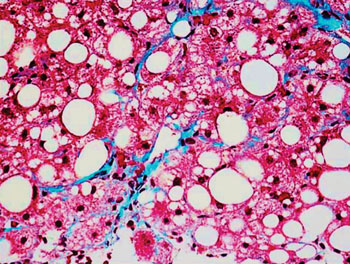Simple Blood Test Vastly Improves Severe Liver Disease Detection
By LabMedica International staff writers
Posted on 19 Oct 2016
A new non-invasive method of predicting the risk of developing a severe form of liver disease could ensure patients receive early and potentially life-saving medical intervention before irreversible damage is done.Posted on 19 Oct 2016
Non-alcoholic steatohepatitis (NASH) is the most extreme form of non-alcoholic fatty liver disease (NAFLD), which is a range of conditions caused by a build-up of fat in the liver. With NASH, inflammation of the liver damages the cells, potentially causing scarring and cirrhosis.

Image: A histopathology of non-alcoholic steatohepatitis (NASH) in a liver biopsy (Photo courtesy of SPL).
An international team working with the scientists at the Cardiff University (UK) used mass spectrometry (MS)-based analytic platforms to measure levels of lipids and metabolites in blood samples from 318 subjects who underwent a liver biopsy because of suspected NASH. The subjects were divided randomly into estimation group of 223 and 95 in a validation group to build and validate the model. Currently, the diagnosis of NASH can only be done with a liver biopsy, which is an invasive and costly procedure. They investigated whether MS-based profiling of plasma improves noninvasive risk estimates of nonalcoholic steatohepatitis (NASH) compared with routinely available clinical parameters and patatin-like phospholipase domain-containing protein 3 (PNPLA3) genotype at rs738409.
The scientists found that features of the metabolic syndrome and the variant in PNPLA3 encoding I148M were significantly more common among subjects with than without NASH. They developed a model to identify subjects with NASH based on clinical data and PNPLA3 genotype (NASH Clin Score), which included aspartate aminotransferase (AST), fasting insulin, and PNPLA3 genotype. This model identified subjects with NASH with an area under the receiver operating characteristic of 0.778 (95% confidence interval, 0.709–0.846).
The team then used backward stepwise logistic regression analyses of variables from the NASH Clin Score and MS-based factors associated with NASH to develop the NASH ClinLipMet Score. This included glutamate, isoleucine, glycine, lysophosphatidylcholine 16:0, phosphoethanolamine 40:6, AST, and fasting insulin, along with PNPLA3 genotype. It identified patients with NASH with an area under the receiver-operating characteristic of 0.866 (95% confidence interval, 0.820–0.913). The NASH ClinLipMet score identified patients with NASH with significantly higher accuracy than the NASH Clin Score or MS-based profiling alone.
You Zhou, PhD, a lecturer and senior author of the study said, “Many people with non-alcoholic steatohepatitis do not have symptoms and are not aware they are developing a serious liver problem. As such, diagnosis often comes after irreversible damage is done. Our quicker and less invasive method of diagnosis could mean that more people with non-alcoholic fatty liver disease could be easily tested to determine whether they are progressing to non-alcoholic steatohepatitis, the more severe form of the disease.” The study was published in the October 2016 issue of the journal Clinical Gastroenterology and Hepatology.
Related Links:
Cardiff University











.jpg)

